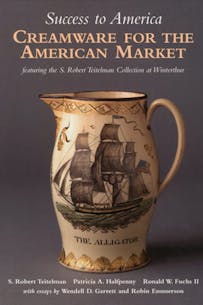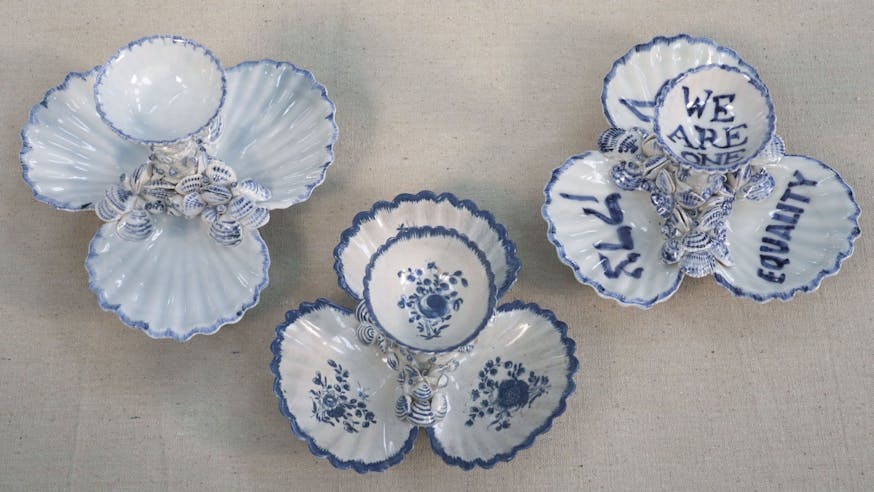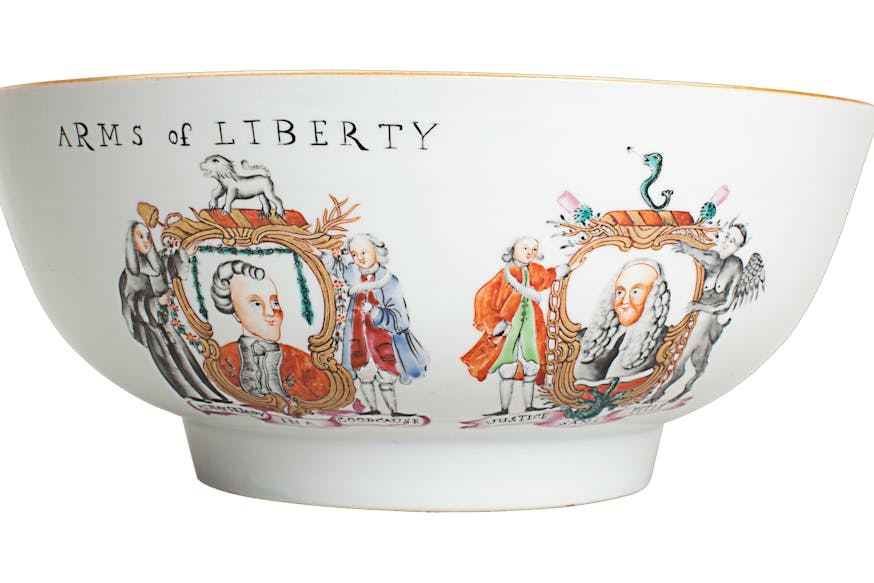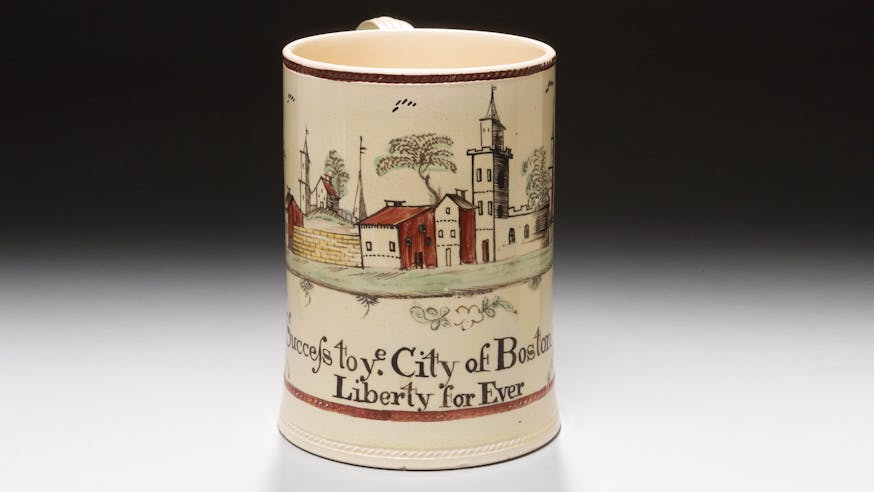Read the Revolution
Success to America
August 8, 2018
Purchase the book from the Museum Shop.
What kinds of objects do you think represent America? Does the Liberty Bell or the American flag come to mind? How about ceramics? In Success to America: Creamware for the American Market, featuring the S. Robert Teitelman Collection at Winterthur, museum professionals relate the creamware trade to the development of an American identity. Creamware, or ceramics made of white clay and flint, was both cheap and fashionable in the American colonies and early Republic. Even though it was a British trade good, many pieces bore American patriotic symbols. The S. Robert Teitelman Collection of creamware at the Winterthur Museum has many pieces with this kind of imagery. They help tell a story of the formation of American national identity. These ceramics were popular throughout America. Even George Washington had an affinity for imported creamware.
Excerpt
In 1769 when George Washington sent an order to his English agent for a new set of dishes to use at his table and in his kitchen, he requested “ye most fashionable kind of Queen’s Ware.” He was ordering English creamware, the most elegant, refined, and stylish earthenware available. This purchase was made despite the troubled relationship between England and her American colony. The leaders of the Colony of Virginia had met in May 1769 and declared that they would purchase nothing of British manufacture after September of that year. Washington met the letter of the agreement by ordering his pottery in late July just weeks before the deadline.
Queen’s Ware was the earthenware of choice in the immediate post-Revolutionary War period. Its smooth, pale surface offered an ideal ground for both the monochrome printed and the polychrome painted inscriptions and imagery that were so popular in the expanding market. At its introduction in the 1740s, this new kind of pottery was called “cream colored,” but following the approval of Queen Charlotte for Wedgwood’s products, she allowed his pottery to be called Queen’s Ware. After 1765 this became the general term for what collectors now call creamware.
Creamware was developed in eighteenth-century Staffordshire, where progress in the pottery industry was usually the result of experimentation and refinement of existing bodies and glazes – innovation mixed with a dash of inspiration. So it was with the earliest creamware. The body was the same as that developed by John Dwight in the late seventeenth century for white salt-glazed stoneware and exploited to its fullest by the Staffordshire salt-glaze potters from the 1720s onward. The body is made principally from ball clay and flint. There was little white clay available in Staffordshire, so it had to be transported from Devon and Dorset. The journey was economically viable because the large coal fields of Staffordshire yielded fuel perfectly suited to pottery making – a long flame that was hot burning, with few impurities. In pottery making, coal was needed in much larger quantities than clay.
[…]
Printed decoration on creamware offered images similar to those printed on paper or published in books. Copying or adapting a design from an existing source was standard practice for engravers in the ceramic industry. It required fewer resources in creation, cost less to produce, and was completed more quickly than an original design engraved from scratch. The cost of engraving a copper plate to print a personalized inscription was rarely worth the expense, and so names, dates, places, and other personal details found on printed pottery were often added in hand-painted enamels.
[…]
By far the greatest number of printed designs for America are devoted to the military hero and first elected president, George Washington, celebrated in life and deeply mourned in death. Prints of Washington as commander in chief of the forces gave way to presidential imagery, but for decades following his untimely death memorials of all kinds continued to be popular. Sources for designs often emanated from America but were then copied and recopied in Europe. It is often possible to trace the original source of a print, particularly of Washington, but it is difficult to identify the specific version of a print that an engraver might have copied. Some pottery pieces are completely decorated with prints devoted to a single subject, and again Washington dominates. Frequently, however, prints on a single piece have no obvious relationship to one another. A bowl with two George Washington prints might also have floral sprays, sailors, or Neptune interspersed. It is difficult to date Washington memorial prints because they continued to be popular for so long.
Expressions of respect and support for Washington are just one phenomenon of the exceptional outpouring of patriotism in the early years of the young American nation. Proud of their hard-won independence, concerned for their continued Union against the rest of the world, and eager to have visible symbols to express their sentiments publicly, Americans bought printed pottery with images and mottoes that were tangible tokens of their patriotism. Popular prints included national symbols such as the Great Seal of the United States. The symbolism of each element of the design was not always fully understood by the English engravers and so there are some interesting interpretations; nevertheless, the designs must have been acceptable to the consumer as the pots survive in great number. It is significant that the Liverpool pottery firm of Herculaneum created an adaptation of the Great Seal for its own mark, placing it prominently on jugs with the factory name below. “Peace, Plenty, and Independence” was a popular slogan; the print is occasionally hand painted with enamel colors and can make a very showy display. “Peace and Prosperity to America,” “Success to American Trade,” and “Free Trade and Sailors Rights” all speak to the fight for a place on the world stage, as war with France threatened then receded, and the English navy continued to impress American seamen. Perhaps the most moving of these patriotic messages is that found on a jug made for David Alden: “May the tree of Liberty that first buded in America spread its branches through the world.”
In celebrating America’s growing international commerce, the most commonly seen print is that of a sailing ship. Most of these were rarely, if ever, intended to depict particular vessels; they were “stock prints” that found favor with ship owners and masters who were willing to take any depiction of a ship and personalize the piece by paying for additional hand painting. Many of these personal pieces are jugs. When the name of a ship, ship’s master, or home port is added, it elevates the level of interest and value for the modern-day collector; when all three details are added, the jug becomes exponentially important. A printed jug may be enjoyed as a wonderful piece of ceramic art, but when it carries personal details that reveal the name of the owner and his place in society or enables us to follow the ship’s voyages through shipping wars and over dangerous oceans, then the jug becomes a more tangible, exciting link to America’s past. The S. Robert Teitelman Collection is rich in such documentary pieces.
This Read the Revolution feature was written by Laura Earls, who is currently working as a Curatorial Intern at the Museum and is a second-year master's student in the History and Museums Studies program at the University of Delaware.
Read the Revolution is published biweekly by the Museum of the American Revolution to inspire learning about the history of the American Revolution and its ongoing relevance.
Sign Up
Get biweekly Read the Revolution featured excerpts right to your inbox.
Tags
Learn More

Making a Bonnin and Morris Pickle Stand

"Arms of Liberty" Punch Bowl
